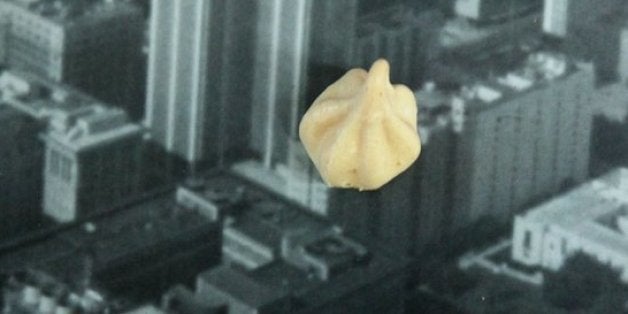
Are “Smog Meringues” -- egg whites whipped in sugar and noxious fumes -- a new level of dessert decadence or an insightful critique of air pollution policies?
The question was posed at last weekend’s “Ideas City,” a New Museum festival in New York City that mixed street stands and speaker panels to examine current and future urban environments. Borrowing its theme from Italo Calvino’s Invisible Cities, this year’s rendition promised engagement with voices and topics that remain transparent or unseen.
Evidently, one such entity is smog, and making it visible meant making it edible.
Vendors positioned outside at Manhattan's Rivington and Bowery offered free, bite-sized meringues in three flavors: “London-Style Pea-Souper,” “Atlantic-Style Biogenic Photochemical” and “Los Angeles in the 1950s.” The names were pristine, the wording ready for retweet, but I wanted a clearer explanation of the stunt’s political basis, its environmental rationale:
“So what exactly ... What are you … Why?” I stuttered.
“What’s the point?” offered a woman, helpfully, as she passed me a pea-souper.
It turned out there wasn’t much of a point, or at least not one that she could provide, save a wonderfully detailed explanation of how the meringues are made. Based on consultation with professors at UC Riverside, the inventor developed a series of containers that house ingredients akin to trash, like orange peels and diesel. When heated under UV light, they combine to form the noxious fumes in which egg whites are beaten. Since meringue is 90 percent air, smog meringue is 90 percent smog!
Different ingredients are selected for each urban airscape. London requires a sulfurous kick, while the Atlanta recipe calls for a pinch of local pine. Listening to the taste profiles, I found, ironically, that any dangers from those ingredients had faded back to Calvino’s invisible realm. Games of molecular gastronomy had taken priority.
An Edible Geography piece from Nicola Twilley, the mastermind behind the smog meringue endeavor, offered a more compelling explanation for the whimsical treats:
"Our hope is that the meringues will serve as a kind of 'Trojan treat,' creating a visceral experience of disgust and fear that prompts a much larger conversation about the aesthetics and politics of urban air pollution, as well as its health and environmental effects."
Let’s parse out that Homeric metaphor: an outwardly attractive dessert, once ingested, releases a team of toxic warriors -- like those hidden inside history's infamous horse -- that furtively infiltrate a body. But once inside, does chaos ensue? Back in Troy, the horse’s initial sweetness was pretty clearly outweighed by the siege's catastrophic repercussions. But with the smog meringue, it's just the opposite. Our digestive systems, Twilley explains, render the treat less dangerous than inhaling toxins -- and they actually taste pretty good. So much for a fall.
On top of the failed metaphor, instead of ushering discussion, the meringues provoked a series of aestheticized tweets and Instagram posts, most of which focused on the quirky idea of the dessert instead of any conversations about pollution. Perhaps, in another era, this would not have been the case, but in today’s cult of circulated images, clever captions can bring more likes and more social validation than serious content. So smog becomes a fun-flavor instead of an invisible force to be feared.
This turn to the frivolous is not the fate of all smog-inspired art. In "Smog Free Project," Dutch designer Daan Roosegaarde has developed an ambitious "smog vacuum cleaner" meant to make a tangible impact on air conditions in first Rotterdam, then China. Cai Guo-Quiang's "Ninth Wave" relied on spectacle, but it managed a mix of forceful and grim, similarly addressing China's pollution crisis with a harrowing display of ill animals.
Twilley’s post shies away from this bleakness, bookending its environmental critique with reflections on “aerior”: a reworking of the term “terroir” to describe the infusion of atmosphere -- rather than soil -- into taste. Future projects, she writes, include matching (presumably haute) street food menus to city-specific air tastes and developing devices that add olfactory “smog seasoning” to meals.
Overall, a gesture was made at pollution critique, but meringues gravitate toward culinary fancies rather than meaningful discussion or true aesthetic intervention. Ideas City had the right impulse to make the invisible visible, but we must be cautious with the forms that visibility takes. Rivington and Bowery is a far cry from Troy, and any horse that is too showy, too saccharine will blind us to the severity of what lies hidden inside.

